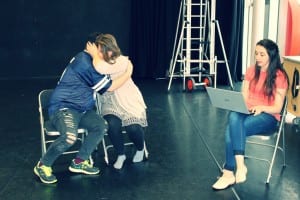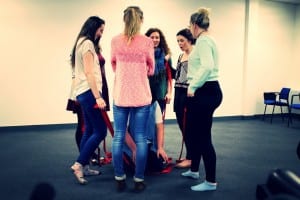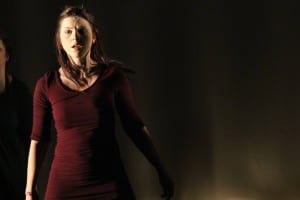So, in these past two weeks we have been working hard and really building up content for the show. In one of our workshops our task as small groups was to look over sources and see how we could develop them into scenes. The text we were given was a story about a couple, one of whom had encephalitis, the disease I talked about in my last blog post. We took this opportunity to work on a scene that emphasised the confusion of the sufferer, for our piece this would be ‘the man’, played by Michael C. The piece we conceptualised in this workshop became known as the time lapse scene. Our aim for the scene was to incorporate all of the performers and have them making contact with ‘the man’ which would trigger him into a number of movements. It was difficult for us to physicalise it fully because there were only three of us but we planned for some basic movements such as Hannah pushing Michael’s head and him falling back. The point is that he is not in control of his own actions. We envisioned the scene to incorporate lifts, as some of the feedback we had from our other material was that it was a bit flat and still, and to be very busy and chaotic, like an organised mess.
In another scene we have developed I am playing the doctor describing the disease, encephalitis. This is the text that I wrote a few weeks ago and it’s finally being integrated into a scene! The layout of the scene is that Michael C. and Alice D. will perform a duet as husband and wife, showing them receiving his diagnosis. Their movements will represent their relationship and the support they have for each other as well as the fear they now both have. My text is read over the movement, and eventually Naomi comes in to take over as the wife to introduce music to the scene. At this stage the idea is that Naomi will start to play the piano and Michael will action the man’s confusion at the words but clarity at the music. I’ve really enjoyed developing this scene because I feel like my strength as a performer is in delivering speech rather than in movement so I definitely feel more comfortable in this scene.

On a very different note we have also developed a ribbon sequence this week. This scene is to represent connections in the brain and how memories are made. Michael W. showed us a video that explained how proteins in the brain are formed when memories are made and how every time you remember something it’s slightly different from the last time you remembered it. We looked at studies into witness of the 9/11 tragedy and how their eye witness accounts from hours after the event, and months after, were significantly different. We wanted the ribbon sequence to show how the connections in the brain can get confused by using ribbons as the connections and physically making them tangle up with us inside. The piece was challenging to choreograph because Rachel needed to be able to see it to advise us on where to go or what we did that looked nice as opposed to what didn’t, but we also couldn’t make anything definite without Rachel performing with us because we needed to have enough connections. Originally we tried the scene with Michael in the centre of us but it just looked messy and like we had just put him there without a purpose, so Michael W. decided that we should just carry on without ‘the man’. Eventually I think we’ve made a very aesthetic piece but it’s going to take a few more rehearsals before it’s ready for the stage!

